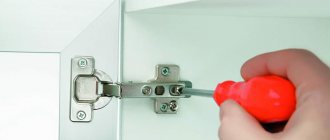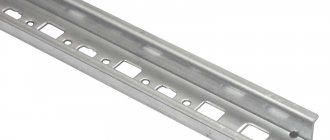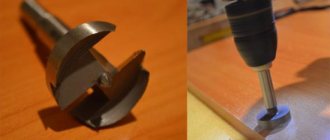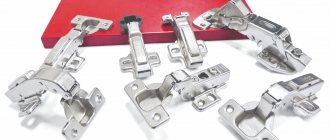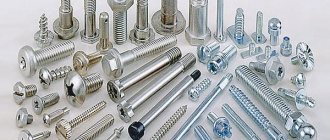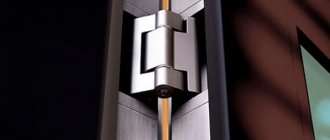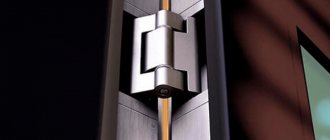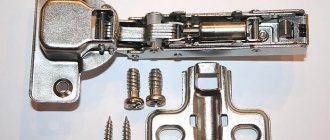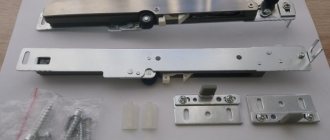How to replace furniture hinges on an old cabinet
As the old saying goes: an old friend is better than two new ones. This also applies to furniture. I want the old, comfortable, favorite wardrobe to serve as long as possible. It is easier to replace fittings than to search for or order a similar piece of furniture.
First you need to determine how door hinges are used and which ones will be replaced. You need a tool, attention and instructions with step-by-step actions:
- Using a Phillips screwdriver, we unscrew the old hinges from the side where they are attached to the sides and, after removing the facades, we unscrew them from the door.
- If you choose the simple option (don’t understand the types of hinges) on how to install hinges on a door, take all the unscrewed elements with you to the store and they will select the same or similar ones for you.
- Screw on the new ones, but make sure that the holes match.
- And the last thing is adjusting the hinges.
After unscrewing the hinges and removing the doors, remember how and where each door hung so as not to waste time re-hanging.
It wouldn’t hurt to invite an assistant to support the door leaf when screwing in the new hardware.
For these steps you will need:
- Screwdriver.
- A ruler or tape measure for measuring the distance between old holes in order to select new ones with an accurate hit.
- A drill with a Phillips bit or the same screwdriver for screwing in new hinges.
Advice from a furniture installer: when installing hinges, it is better to replace the mounting screws with new ones.
If you are doing everything for the first time, it will not be superfluous to first understand the structure of the loop itself and its components.
Types of four-hinged furniture hinges
There are many types of hinges, but the most common are four-joint hinges or, in common parlance, a “frog hinge.” Such products are easy to use and can last for quite a long time.
The name itself contains the main element that powers them - hinges. In addition to them, there is also a base (or baset) and a cup.
Their types:
- Inset hinges.
- Semi-overhead
- Overhead loops.
- Angular.
- Inverse.
The difference will be in the overlap of the facade on the sidewall and the different angles of the closed doors relative to the sidewall adjacent to the hinges.
90 degree hinges
The design directly influences the choice of type. If the door is fastened in the closed position at an angle of 90°, then these are the ones you need:
- The card makes it possible to open the doors as much as possible. However, their use is rarely resorted to. Their functionality has the main disadvantages: there is no possibility of adjustment and an additional magnet must be installed.
- Furniture. Its use is hidden in the name itself. It is their furniture manufacturers who put it on their products.
But it's important to know! That ordinary furniture hinges 90 degrees are also divided into overhead, semi-overlay and inset:
Invoice
Their greatest popularity is due to the standard design of a complete overlap on the sidewall, covering the entire end of the sidewall.
Half waybill
At first glance, even for a beginner, the difference between an overhead and a semi-overlay loop will be visible. The second has a slight bend, it is located on the so-called shoulder lever. Thanks to this, when the facade is closed, there will only be half of the end of the wall.
They are used in cabinets when two doors are attached to one side panel from different sides.
Inset loop
The difference between an overhead and an inset hinge is the same as the previous one - there is a bend on the shoulder lever, but noticeably more than on a semi-overlay. Because of this bend, when the facade is closed, the end of the wall will be completely visible.
They are used in furniture when the facades need to be deepened inward in relation to the ends.
Transformer
The peculiarity is immediately visible - the special shape of the eight-jointed shoulder lever. In terms of its characteristics, the transformer hinge is similar to a standard 90 degree overhead hinge. Its advantages: the ability to open the door entirely up to 165°, compared to the standard one - 90°. Typically used when drawers or baskets are located behind hinged doors.
Their difference from the others is the bulky shape of the shoulder. Other names are carousel, crab or crocodile.
180 degree hinges
This view allows you to open the door and position it so that it is flush with the wall of the base when closed. Another name is inverse or under the false panel. Its purpose is for corner (not trapezoidal) kitchen cabinets.
Corner hinges
The types of corner hinges differ in the angle at which the facade will be pressed:
- 30°
- 45°
- 120-135°
- Carousel. For connecting 2 facades, the bonding angle is 270°.
- With negative opening angles. Due to their design, their use is extremely rare.
Other types of loops
Since there are many types of furniture, therefore, there should be sufficient quantities of accessories for it.
Other types of loops include:
- Card.
- Pianos.
- Pendulum or bar.
- Mezzanine.
- Ombre designs.
- Secretarial.
- Adit.
- Heel.
- Hinges for glass doors.
Each type has its own purpose and mounting features. For example, heel hinges are designed for lightweight doors and will be fastened in the upper and lower parts of the doors. Glass doors use special fittings that not only look beautiful, but can withstand weight.
Types of furniture hinges by design
There are many hinges and canopies used to attach a swing door to the frame of a cabinet or cabinet. Basically, in modern furniture production, four-hinged hinges , which allow the facade to be adjusted in three planes at once:
- higher lower,
- left/right,
- to/from the facade.
All of them consist of two interconnected parts - a bowl with an elbow and a strike plate . Often the strike plate is called a mounting or mounting plate. This article will focus specifically on four-hinged hinges.
Other types of furniture hinges can be combined into one large group as “bowlless” hinges.
piano hinges, card hinges, pin hinges, and heel hinges, known to everyone for fastening interior doors and facades in old furniture . They are rarely used in modern furniture. For example, piano, card and mortise hinges can be used to attach tabletops to the base, movable legs in book-tables. For ordinary cabinets, brass decorative hinges are used as additional decor.
Overhead hinges that do not require drilling of the facade . They come in handy when the thickness of the material chosen for the facade does not allow installing (embedding) a four-hinged hinge due to the depth of the bowl. The only drawback of such hinges is their rigid fastening, which does not allow adjustment in three planes, like four-hinge hinges.
Hinges for fastening specific facades . For example, prefabricated facades made of aluminum frames of different widths are installed on special hinges - you can purchase them together with the profile. Please note that, just like regular four-hinged hinges, they can be overhead or internal, designed for corner cabinets of 45, 135, 180 degrees and facades covering the end of the case.
Loop functionality
The installation of furniture hinges on cabinet doors is carried out to open and close doors. But it is also worth understanding what the movement should be? Smooth? Not loud? Which hinges should be screwed on so as not to lose their functionality?
Standard
Standard hinges perform basic tasks and nothing more. Their disadvantage may be a smooth, loud slamming, due to the pressure spring for closing the door.
With door closer
The classification of hinges with a closer is similar. It all depends on the type of overlap of the facade on the sidewall and their mating angle. The difference is a built-in or overhead mechanism that cushions the closure. Another plus is the quiet movement.
Hinges without spring or with return spring
This use case is suitable for lovers of minimalism and opponents of unnecessary accessories. The basis was a push-to-open or TIP-ON type pusher and reverse-action hinges with a spring mechanism that works to open the door or without a spring at all.
Opening occurs by simply pressing the facade. Tip-on is installed separately from the hinges, and is used for swinging facades of any volume.
Quick release
The ease of quick installation and dismantling is the main advantage, which does not affect the quality of the hinge's main function. These include Click-On and CLIP-TOP systems. Installation and removal of furniture fronts without a screwdriver, with easy snapping.
Types of strips for furniture hinges
As a rule, hinges are visible only from the inside and operate on the basis of a spring mechanism, which allows you to always keep a particular door closed. In turn, the mounting plate provides the possibility of three ways to arrange a loop:
- overlay - movement left and right;
- depth - forward and backward movement;
- vertically – movement up and down.
The strip attached to the furniture wall has a cross-shaped design and special elongated connectors that allow you to adjust its height at a minimum level of 1–2 mm. The distance between the centers of the holes is 32 mm. They are located along the edge of the wall on which the plank is attached. For overhead and semi-overlay hinges, holes in the furniture wall for the cross-shaped mounting strip are made at a distance of 37 mm from the front edge of the wall.
Depending on the type of furniture and design, this part has a different distance (height), so its choice should be approached responsibly. Height refers to the rise of the base of the hinge above the wall to which the mounting plate is attached. Approximate values in mm: 0.1.5, 2, 3, 4, etc.
The distance, for overhead and semi-overlay hinges, affects the degree of overlap of the hinge part of the sash on the end of the side wall, and for inset hinges - on the size of the so-called. fugue (gap) between the end of the hinge part of the sash and the side wall.
Steps for installing hinges on a cabinet with your own hands
The sequence of steps for installing hinges is half the success. Start by purchasing quality hinges that will last for years. Be prepared for the fact that inserting hinges requires more than just a screwdriver.
In addition to this, you will need to prepare:
- Forstner drill 35mm or 26mm.
- Screwdriver or drill.
- Ruler and square.
- Pencil.
- Level.
- Self-tapping screws for furniture hinges.
If this is your first time seeing a Forstner drill, then you should know that the diameter of the drill corresponds to the bowl of the hinge, this simplifies the drilling and installation process.
Marking
Working by eye is not the best option. Installing furniture hinges with your own hands must be precise, so markings are necessary. The insertion of furniture hinges begins with a distance of 7-12 centimeters from the edge of the door. For convenience, you can use a template for marking. If there are several canopies, then keep in mind that the distance between them should be at least 50 cm.
The number of hinges depends on the façade parameters (dimensions and weight).
How to drill a hole for a hinge cup
The additive is done after laying the canvas on a horizontal, flat surface. In order not to damage the facade, do not make recesses larger than 1.2-1.3 cm. The distance from the edge of the facade to the beginning of the hole is 4-5 mm, so the distance to the center of the hole is 21-22 mm.
Attaching the hinge to the door
Before inserting furniture hinges, you need to check them by placing them on the door. All inaccuracies in the applied markings will be immediately visible. This will avoid misalignment in the future. After correcting all errors, carefully fix the hinges with a screwdriver or screwdriver.
Installation of the strike plate
To install the striker plate, furniture hinges are also marked and holes are drilled. Here you need to use a level so that the internal installation of the hinges is level.
Hanging the facade
After marking and attaching all the parts on both sides, you can answer the question of how to hang the doors on the cabinet:
- Mark the locations for installation of mounting locations for hinges.
- Attach a platform for attaching façade hinges.
- We attach the door to the side of the cabinet.
- Connect the loops.
- The setting is made relative to the locker.
It is better to hang the door on a flat horizontal surface. This will help avoid distortions and problems with opening in the future.
Types of adjustment
Adjustment of furniture hinges occurs in depth, vertically and horizontally. The proximity or weakening of the door to the base is checked by adjusting the depth. The process is carried out with a screwdriver and tightening the oval hole.
You need to adjust horizontally to check whether the door moves from left to right. Similar actions are resorted to in rooms with uneven floors.
Vertical adjustment of the hinges is needed to select the desired height. This happens by twisting the oval holes.
Where to buy a mounting plate for hinges?
The easiest way to buy a door striker is through our company, since many years of experience in the sale and installation of furniture fittings have allowed us to create catalogs from the best quality parts. Their reliability, functionality and durability have been tested by more than one buyer - both those who do home repairs themselves and large enterprises that order materials in large volumes.
The price of the mounting strip in our online store is reasonable and affordable, and the choice is very wide. Sometimes it is difficult to understand exactly what size you need a particular part. In this case, the easiest way is to write to our online consultant, who specializes in professional assistance to clients. He will always explain and give advice, point out the shortcomings and positive aspects, so that you know for sure what you spent your money on.
Calculation of the number of loops
How many loops you need to install depends on the weight and size of the fabric. The larger it is, the more fastenings will be needed. It is important to choose non-flimsy structures. If possible, it is better to seek the help of specialists.
If this is not possible, find out the weight of the door leaf. For example, you have 2 fronts made of chipboard, 500x300mm and 1600x400mm. Then here you will need to fasten 2 loops in the 1st case and 4 in the second. The larger the door area, the greater the weight.
Previous entry Computer chair creaks. What to do and what to lubricate?
Next entry How to properly plan a kitchen: layout, ergonomics and rules for the location of equipment

